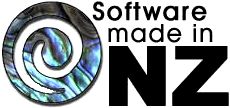
Crusader is an integrated Enterprise Resource Planning (ERP) and financial management solution designed for growing small to middle-sized New Zealand companies that want the freedom to focus on their business. It has been developed over the last 30+ years in close association with clients who have committed their entire enterprises to the functionality provided by Crusader.
Read Holdfast's recommendation - dated January 1991
Because change is “normal” in business, it has been vital for it to be “normal” in Crusader too. I felt strongly that clients should not have their staff wasting their time working around methods imposed on them by their computer systems, but rather “bend” Crusader to match the way each client worked.
As a result, I designed Crusader literally from its inception to support an unlimited level of customisation without losing the ability to incrementally upgrade to the current version of Crusader software. (Achieved by making the core Crusader code behave like an interpreter, reading scripts to define form and function.) This aspect has perhaps been its most significant benefit, as it has allowed approximately monthly updates to be delivered throughout the product’s 30+ years of use.
Fully integrated operation and in-built security (missing from many other systems dating from the same time in the 1980s) were also essential elements. Crusader integrates all operational activities into a single version of “the truth” continuously maintained in the current state.
Features;
-
Integrated and automated update system that has allowed an Agile approach to ongoing development with incremental improvements distributed throughout Crusader’s history
-
Unlimited capability to make changes without affecting the regular updates
-
Customer relationship management with marketing support
-
Customer accounts (quotations, sales orders, stock delivery, accounts receivable) with complex statistical analysis
-
Unlimited number of price lists, with discounting and special fixed pricing over-rides
-
Basic point-of-sale function (designed for warehouse sales rather than a retail operation)
-
Sales representative management, including sales cycle management
-
Supplier accounts (purchasing, stock receipting, accounts payable)
-
Automated purchasing, including requirements forecasting based on a complex analysis of sales and usage history that generally provides correct results, allowing a “just in time” approach to inventory management
-
Inventory Management (the usual range of functions) including multi-site, multi-location, multi-type
-
A special case for roofing where the product quantity consists of a number of sheets of a given length is used to calculate the total length of product
-
Product batch management, which can also be applied to account for the usage of bulk materials such as rolls of paper or tanks of adhesive during manufacture
-
Warehouse management features that allow optimised storing and picking of product
-
Import cost projection and analysis
-
Bar-coded batch tracking
-
Manufacturing with unlimited levels of the bill of materials
-
Product cost and pricing management with the ability to automatically selectively revalue both costs and selling prices, based on bills of materials if applicable
-
Job management that allows the tracking of time and materials used, contract tracking against budget, and staged billing
-
Financial management with flexible reporting
-
Flexible e-commerce features including EDI support for sales orders and invoices, e-mailed invoices and statements in PDF format, and online web-based transactions
-
Support for mobile client connection, reporting and additional functionality via a real-time bidirectional interface with SQL server
-
Flexible reporting method capable of being used by a client, with minimal training
-
All customers, suppliers and inventory are managed into multi-layered groups for various control functions and financial postings
-
Hundreds of “standard” reports, all of which can be heavily customised
-
Multi-level drill-down through transaction layers to quickly expose the results of any transaction
-
Many ease-of-use functions, especially those that provide quick enquiry ability without needing to exit from the existing transaction, edit screen, etc.
All functionality is integrated into a cohesive package that users quickly understand, as the presentation is customised rapidly to match the business’ culture and requirements. Users are only presented with such menus, screens, and reports as are relevant to the business. These only include such data fields that apply to the system's efficient operation. As a result, training has not generally been required.
Because Crusader is fully integrated, and clients have run only Crusader to meet all their business needs, there has been no need to maintain the data in multiple systems or to interface between systems. The Crusader “culture” is consistent throughout. When improvements have been released through the automated monthly update, they have consistently affected all parts of the system, including customised areas and even areas created using custom code. This is because Crusader provides a few core functions that deliver all transaction processing and presentation layer functions, and custom programs call these functions, thus “future-proofing” the customisation. This is how Crusader has continuously met clients' changing needs with quite different and complex businesses for more than 30 years.
With the exception of the .Net code written to facilitate EDI transactions and the interface with SQL, as the sole developer, I wrote all Crusader code in a structured methodology based on the "Pick" (Rocket D3) database.
